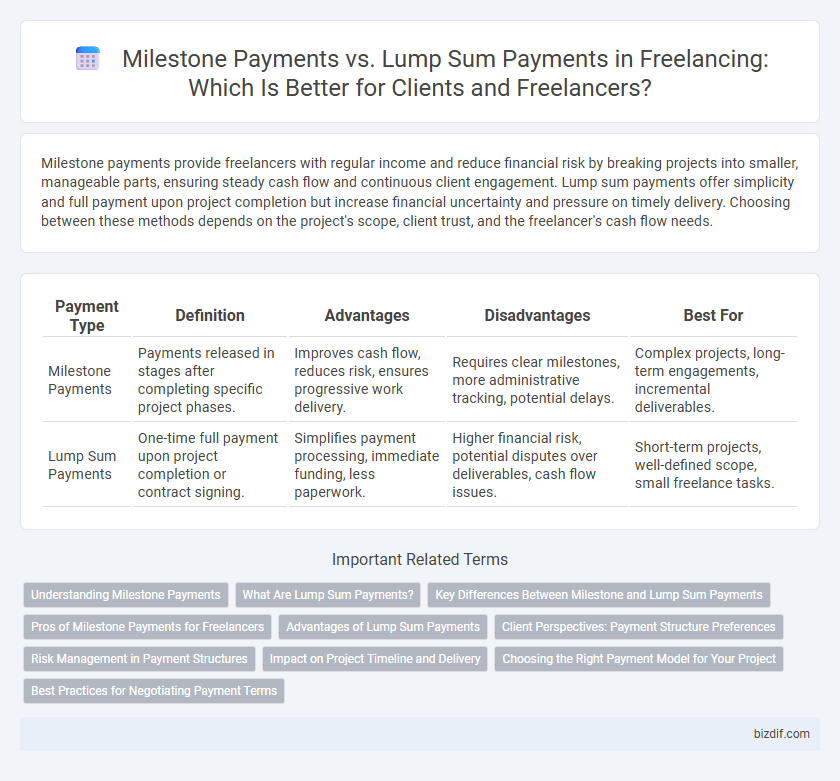Milestone payments provide freelancers with regular income and reduce financial risk by breaking projects into smaller, manageable parts, ensuring steady cash flow and continuous client engagement. Lump sum payments offer simplicity and full payment upon project completion but increase financial uncertainty and pressure on timely delivery. Choosing between these methods depends on the project's scope, client trust, and the freelancer's cash flow needs.
Table of Comparison
| Payment Type | Definition | Advantages | Disadvantages | Best For |
|---|---|---|---|---|
| Milestone Payments | Payments released in stages after completing specific project phases. | Improves cash flow, reduces risk, ensures progressive work delivery. | Requires clear milestones, more administrative tracking, potential delays. | Complex projects, long-term engagements, incremental deliverables. |
| Lump Sum Payments | One-time full payment upon project completion or contract signing. | Simplifies payment processing, immediate funding, less paperwork. | Higher financial risk, potential disputes over deliverables, cash flow issues. | Short-term projects, well-defined scope, small freelance tasks. |
Understanding Milestone Payments
Milestone payments break a project into specific stages, ensuring freelancers receive compensation for completed tasks, which mitigates financial risks and improves cash flow management. This payment structure enhances transparency and accountability by clearly defining deliverables and deadlines, fostering trust between clients and freelancers. Understanding milestone payments enables freelancers to negotiate fair terms, protect their work, and maintain steady income throughout the project lifecycle.
What Are Lump Sum Payments?
Lump sum payments refer to a single, fixed amount paid to freelancers for the entire scope of a project, regardless of the time or effort involved. This payment structure offers clarity and simplicity, minimizing administrative overhead and ensuring freelancers receive full compensation upon project completion. Lump sum payments are ideal for well-defined projects with specific deliverables and clear deadlines, providing predictable budgeting for clients.
Key Differences Between Milestone and Lump Sum Payments
Milestone payments break a project into smaller, manageable phases where clients release funds upon completion of specific goals, ensuring continuous progress and reducing financial risk. Lump sum payments involve paying the entire agreed amount upfront or at project completion, which can simplify budgeting but may expose clients to higher risk if deliverables are delayed or subpar. The key difference lies in payment timing and risk distribution, with milestone payments promoting accountability and lump sum payments offering streamlined transactions.
Pros of Milestone Payments for Freelancers
Milestone payments provide freelancers with consistent cash flow by breaking projects into manageable phases, reducing financial risk and ensuring steady income. This payment structure also enhances client trust and accountability, as each milestone requires deliverable approval before funds are released. Freelancers benefit from clearer project scope and improved motivation, promoting timely completion and higher-quality work.
Advantages of Lump Sum Payments
Lump sum payments offer freelancers immediate access to the full project amount, enhancing cash flow management and reducing financial uncertainty. This payment method simplifies accounting by eliminating the need for multiple invoicing stages, allowing freelancers to focus entirely on project delivery. Moreover, lump sum payments foster strong client trust by demonstrating commitment and efficiency from the outset.
Client Perspectives: Payment Structure Preferences
Clients often prefer milestone payments because they allow for better project oversight and reduce risks by releasing funds based on completed deliverables. Milestone payments enhance trust and accountability, enabling clients to assess progress and ensure quality before advancing payment. Lump sum payments may appeal to clients seeking simplicity, but they carry higher financial risk due to limited control over intermediate project stages.
Risk Management in Payment Structures
Milestone payments mitigate financial risk by breaking a project into smaller, manageable segments, ensuring freelancers receive partial compensation as work progresses. Lump sum payments concentrate risk, potentially delaying freelancer income until project completion and increasing exposure to client non-payment. Structuring payments around milestones enhances cash flow security and encourages timely project delivery in freelancing agreements.
Impact on Project Timeline and Delivery
Milestone payments create structured checkpoints that encourage timely progress and help identify delays early, enhancing overall project timeline adherence. Lump sum payments may reduce administrative complexity but risk delayed delivery if the freelancer lacks incentives to meet interim deadlines. Projects with milestone payments typically benefit from improved accountability and more predictable delivery schedules.
Choosing the Right Payment Model for Your Project
Milestone payments enhance project management by breaking down deliverables into smaller, manageable goals, reducing financial risk and enabling better quality control. Lump sum payments simplify transactions by providing a fixed budget upfront, ideal for well-defined projects with clear scopes. Selecting the right payment model depends on project complexity, client trust, and the need for flexibility in managing timelines and deliverables.
Best Practices for Negotiating Payment Terms
Milestone payments offer freelancers greater financial security by breaking projects into manageable segments tied to specific deliverables, reducing risk and ensuring steady cash flow throughout the project. Lump sum payments require clear contractual agreements upfront and detailed scope definition to protect both parties from scope creep and payment disputes. Best practices for negotiating payment terms include setting transparent expectations, defining clear milestones or deliverables, and aligning payment schedules with project progress to balance client trust and freelancer motivation.
Milestone payments vs Lump sum payments Infographic

 bizdif.com
bizdif.com